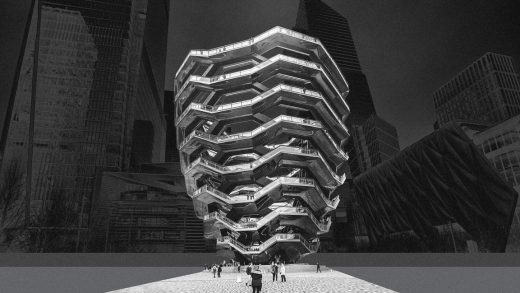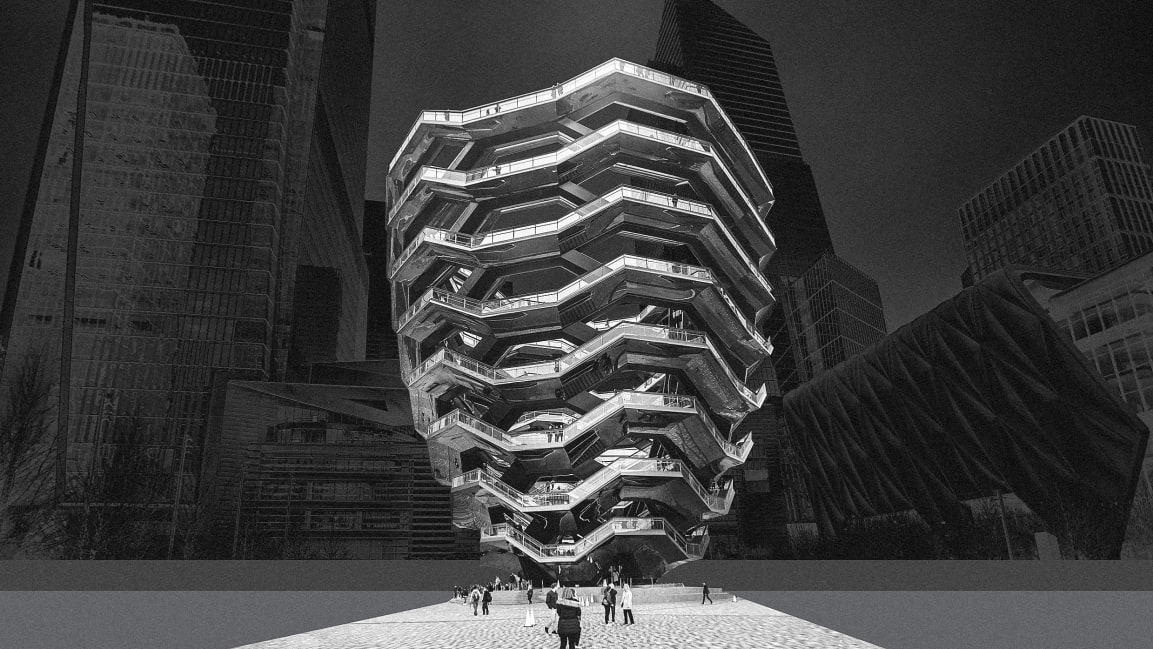Learning from the Vessel: How cities can be designed to prevent suicide
On July 29, a 14-year-old boy jumped to his death from the Vessel, the extravagant installation at the heart of Hudson Yards in Manhattan.
This is the fourth suicide that has occurred there since the pseudo-public space, with its labyrinthine stairs to nowhere, opened to the public in March 2019. Remarkably, it is also the second time that the Vessel has closed due to a suicide: After the third death in January 2021, new safety measures were put in place, including increased security, a buddy system, and signs with mental health resources. It took only two months for those mitigation techniques to prove ineffective.
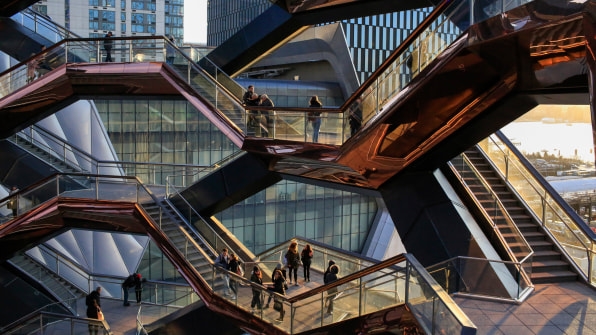
What happened at the Vessel—which was dreamed up by British designer Thomas Heatherwick and developed by Related, billionaire Stephen Ross’s real estate firm—is devastating, but not unexpected. Before the Vessel first closed, residents and critics had raised concerns that its waist-high barriers could pose risks, compounded by the unobstructed 150-foot-high drop to the ground that the tapering structure provides.
“The team exhaustively explored physical solutions that would increase safety,” Heatherwick Studio said in a statement, noting that these solutions needed “further rigorous tests.” Reportedly, Heatherwick had designed higher safety barriers that Related never installed—although it’s unclear if that was before or after the first suicides took place. (In a brief statement, a spokeswoman for Related said they were “heartbroken” by the recent suicide and reiterated that the Vessel is currently closed.)
While it’s unclear why Heatherwick’s barriers weren’t implemented, it’s hard not to speculate. With a whopping $200 million price tag, the Vessel was publicized as New York City’s newest landmark. Described on Related’s website as a “vertical climbing experience” with “some of the most unique views of the West Side,” it was intended as a public ornament, a “gift” to the city. Presumably raising the height of the glass barriers, despite their transparency, could have spoiled the experience.
But the truth is that the four deaths may well have been prevented without compromising on the Vessel’s design. In fact, design can be part of the solution to prevent suicides in public spaces. Based on past examples, suicide prevention needn’t be an eyesore. It can be done in a way that is functional, elegant, and doesn’t instill fear. It can even enhance the overall aesthetic experience.
While some studies show that raising barriers simply redirects suicidal people elsewhere, putting up obstacles has also been proven to save more lives, particularly among children and young adults, who tend to act on impulse. The four people who died by jumping from the Vessel were 14, 19, 21, and 24 years old. In fact, suicide is the second leading cause of death for children, teenagers, and young adults ages 15 to 24.
In her doctoral thesis on suicidal situations in outdoor public places, researcher Charlotta Thodelius observed that suicidal thoughts among young people are often impulsive and preventable. In western Sweden, where she conducted her research while at the Chalmers University of Technology, suicide “hot spots” like bridges, train stations, and high buildings were often easy to access or empty, with a low degree of visibility. “This makes it possible to prevent suicides or suicidal situations by a well-thought-out design,” she says. “I think we can work with place and architecture in the same way that society has worked to limit access to lethal products to prevent suicides.”
Thodelius explains that suicide in public places many times follows what is called a “suicidal script,” in which “suicidal persons often have a vision of where they will commit suicide.” She notes that every region has a “local hot spot.” In the south of England, it’s the precipitous cliffs at Beachy Head. In San Francisco, it’s the Golden Gate Bridge.
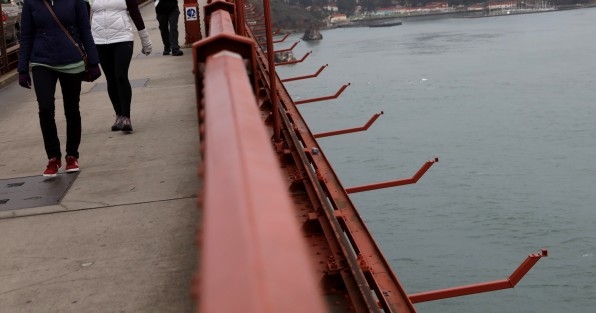
[Photo: Justin Sullivan/Getty Images]
Since the Golden Gate Bridge was built in 1937, about 1,700 people have leapt to their deaths (although this figure is likely higher since not all bodies are recovered and not all victims are witnessed). The construction of a suicide deterrent net began in 2019; after major delays, it is now slated for completion in 2023.
According to the nonprofit Bridge Rail Foundation, which advocates for suicide prevention in public spaces, the average age of people who jump from the Golden Gate Bridge is under 40, and of the few who have jumped and survived, many reportedly did not have a backup plan for killing themselves. Thodelius’s research, while not referencing the bridge directly, seems to confirm this: “If the access to a certain place is restricted, they rarely switch location,” she says.
This point has been much debated among researchers, but there does seem to be a consensus that restricted access is most likely to deter younger populations. Thodelius says it’s crucial to find ways to design obstacles without instilling fear or negative emotions. “Often, when we discuss prevention and security, we think it needs to be a harsh design such as rough steel fences,” she says. “The most difficult task is to keep the ordinary functions of places for everyday activities undisrupted while at the same time preventing suicidal situations.”
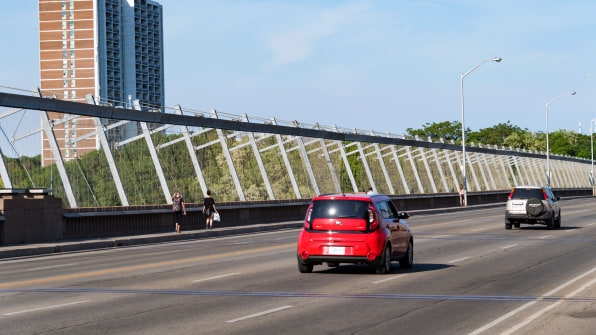
[Photo: Roberto Machado Noa/LightRocket/Getty Images]
When it comes to bridges, nets and tall fences are common deterrents, but in 2003, the city of Toronto took a more creative approach at the Bloor Viaduct. Once the second-most-frequented bridge for suicides in North America (after the Golden Gate), the Bloor Viaduct counted an average of nine deaths a year before the city commissioned the Luminous Veil—a seemingly kinetic metal barrier made of thin, steel rods that light up at night in a way that changes daily according to the season, temperature, and direction of the wind.
Since the barrier went up 11 years ago, only one person has died by suicide at the bridge. And while it’s not entirely clear whether this dissuaded people entirely, a recent study suggests that suicide rates across the city have indeed dropped since the barrier was erected.
As it is with deeply entrenched issues surrounding mental health, there are two frameworks to consider when dealing with suicide prevention: In the short term, tangible mitigation techniques like nets and barriers can help save lives; in the long term, the built environment can be rethought more broadly to help improve mental health. In Manhattan, New York University’s Bobst Library provides a striking example of a relatively short-term solution that combines creative thinking with effective suicide prevention.
Less than two miles from the Vessel, the library’s formerly open atrium had attracted two students who jumped to their death in 2003. And despite the 8-foot-tall plexiglass barrier that was installed afterward, another student managed to clamber over and jump in 2009.
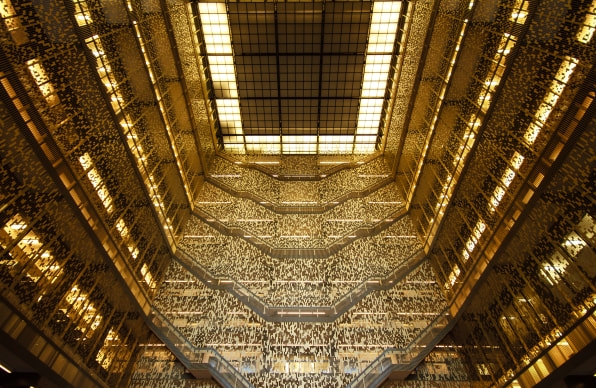
[Photo: Jonny McHugh/Getty Images]
The solution came in 2012, in the shape of the Bobst Pixel Veil—a floor-to-ceiling, laser-cut screen that encloses the skylit atrium with an almost ethereal, intricately perforated bronze membrane glinting in the sunlight.
Some critics have called for the dismantling of the Vessel, but if it were to remain, Heatherwick could no doubt come up with a similarly striking mitigation technique (provided Related agrees). But what about the longer-term course of action?
“In the long run, we need to find ways to include mental health in the design of the places and spaces that surround us,” says Kevin Bennett, a teaching professor of psychology at Penn State Beaver and a fellow at the Centre for Urban Design and Mental Health in London.
“People around the world, especially in urban environments, are feeling increasingly isolated and disconnected,” Bennett says. He believes that places should be built that slow the development of depression, anxiety, and other mental illnesses by designing for face-to-face interactions and increased mobility.
For Bennett, the root of the problem with the Vessel is that it is not an inclusive work of architecture, and it doesn’t serve a function that is beneficial to citizens. “Heatherwick’s Vessel functions mostly as an art installation that only some able-bodied users can use as stair-stepping exercise equipment,” he says. “If we can build better places, we can reduce the rates of suicide, not by eliminating bridges and other tall buildings, but by creating places that promote chronic happiness and well-being.”
If you or someone you know is in crisis, call the National Suicide Prevention Lifeline at 1-800-273-8255, text TALK to 741741, or visit SpeakingOfSuicide.com/resources for a list of resources.
(39)

